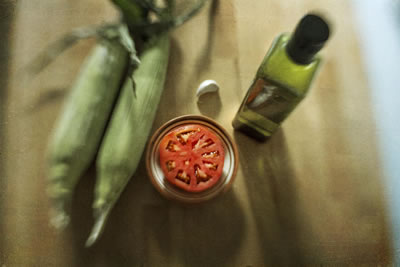The Tempest
A Concoction Strange and Wondrous
No matter the actual locale of the play—the Bahamas, since Shakespeare used the true accounts of a shipwreck on that archipelago as one of his sources, or a mysterious island somewhere in the Mediterranean—Prospero's island is not only magical, it's exotic. It is lush, inhabited by strange beings, and the air is filled with music.
That is the governing idea when preparing a menu based on the play's imagery. Aside from foodstuffs representing the island itself (tropical) or its travelers (Italian), the items that make up these dishes must be somehow “exotic,” of another place (from a European point of view) and—true to Prospero's calling as a magician—a concoction strange and wondrous.
 So, my main course, “Prospero's Feast,” which Ariel and his fellow spirits could very well present to the castaways in their mirage moment, represents the various elements of the mysterious island: fish from the sea, a forest of broccoli exuding a tropical scent, and exotic fruits sautéed in butter. Taking inspiration from Prospero's magical cloak and keeping true to the island's actual locale in the Mediterranean, we cover the fish in a pomegranate sauce, that region's most exotic fruit.
So, my main course, “Prospero's Feast,” which Ariel and his fellow spirits could very well present to the castaways in their mirage moment, represents the various elements of the mysterious island: fish from the sea, a forest of broccoli exuding a tropical scent, and exotic fruits sautéed in butter. Taking inspiration from Prospero's magical cloak and keeping true to the island's actual locale in the Mediterranean, we cover the fish in a pomegranate sauce, that region's most exotic fruit.
Upon hitching his fortunes to Stephano, island native Caliban offers to “bring thee where crabs grow, and I with my long nails will dig thee pig-nuts, show thee a jay's nest…bring thee to clust'ring filberts” (II.2.166). His offering becomes the elements of our starter, an angel hair pasta nest with crabmeat, cashews, and Romano cheese—something the Italian butler might make with the ingredients Caliban brings him. The other island native, Ariel, that sprite of air, inspires our dessert, a lime chiffon pie topped with pecans.
Then there's Ferdinand's punishment. Prospero threatens Miranda's suitor with a diet of “fresh-brook mussels, withered roots, and husks wherein the acorn cradled.” Such a diet would be glorious punishment, indeed, as presented in our secondary meal, a lunch of mussels served in a tomato broth of turnips and corn.
Eric Minton
October 31, 2014
PROSPERO'S FEAST
1/2 cup butter
1 Mango *
Small papaya (or half of a large papaya) *
2 Kiwi *
(* If not available, you could substitute pineapple or another exotic fruit in season)
Broccoli crown
1 Lime
1 cup pomegranate juice
1 tablespoon sugar
1 tablespoon cornstarch
1 tablespoon Madeira
2 Swordfish steaks
Olive oil
Prepare all the ingredients before cooking, as follows:
- Melt the butter over low heat, and when melted turn off the heat. You will be using clarified butter, so skim off the foam and have a fine-mesh strainer ready.
- Peel the mango and cut into bite-size chunks. Peel the papaya, remove the seeds and pulp, and cut into bite-size chunks. Peel the kiwi fruit, slice and halve the slices.
- Cut the broccoli crown into individual “trees” and place into a steamer.
- In a saucepan, mix the pomegranate juice with the sugar. In a cup, mix the cornstarch and Madeira.
- Preheat the oven to 425 degrees.
- Pour a bit of olive oil into a baking dish, just enough to coat the bottom of the dish. Place the fish steaks in the baking dish.
Now for the cooking.
- Place the fish in the oven and bake for about 15 minutes for 2-inch steaks. Turn at the halfway point.
- Start heating the pomegranate juice over medium-high heat.
- Pour the butter through the strainer into a medium skillet and heat over medium-high heat.
- Start steaming the broccoli.
- Back to the large skillet: Add the mango and sauté until each piece is fully coated. Stir in the papaya, then stir in the kiwi. With every chunk of fruit coated, reduce the heat and cover.
- Now to the pomegranate sauce. As it starts to boil, stir in the cornstarch/Madeira mixture until thick. Remove from the heat.
- Out comes the fish.
Move the fish on a plate alongside the broccoli and sautéed fruit. Ladle the pomegranate sauce over the fish. Cut the lime in wedges and squeeze over the broccoli. Serve.
Wine Pairing: A thematic as well as tasty choice is a Vermentino from Sardinia, an Italian island on the way from Milan to Tunisia. At the least, Vermentinos won't clash with this fruit-and-fish dish, and the Argiolas Costamolino Vermentino actually matches well with this sweet-and-tangy meal. If you can't find a Vermentino, an Italian Pino Grigio is a suitable though unimaginative alternative, and a New Zealand sauvignon blanc makes a splashier pairing and gives the dish a more tropical presence.
From one cook to another
Inevitably, we had sautéed fruit and pomegranate sauce left over. So, a couple of days later, instead of going to the market to get fresh swordfish, we just thawed out a couple of boneless chicken breasts. The pomegranate on chicken combination was so perfectly fantastic I actually considered changing the fish out with chicken, but I couldn't find allegorical justification (Ariel flies, yes—but do chickens?). Besides, absolutely fresh swordfish is a gift for your taste buds, but if it is not available, chicken is a tasty if not thematic substitute.
CALIBAN'S OFFERING
1/4 cup cashews
1 spring onion
2 ounces Picoroni Romano cheese
2 tablespoon butter
4 ounces crabmeat
4 angel hair pasta nests
Break up the cashews. Chop the spring onion. Grate the cheese.
Boil salted water in a pot for the pasta and start melting the butter in a skillet over medium-high heat.
Stir the spring onion and crabmeat into the melted butter and add the cashews. Sauté.
Using a Chinese skimmer or a strainer with a handle, insert the pasta nests into the boiling water one at a time. Cook until al dente, about three minutes, but try to maintain their shape.
Remove the pasta from the pot, drain, and place each into a bowl. Pour on the crabmeat/nut mixture and scatter the cheese over the top.
ARIEL PIE
9-inch baked pie shell
4 eggs, divided into yolks and egg whites
1/2 cup plus another 1/2 cup sugar
2/3 cup water
1/3 cup lime juice
1 envelope unflavored gelatin
1 lime
1/2 teaspoon cream of tartar
1/2 cup chopped pecans
Bake the pie shell.
Beat the egg yolks and mix with 1/2 cup of sugar, water, lime juice, and gelatin in a saucepan. Heat over medium heat to boiling, stirring constantly. Remove from the heat and stir in lime peel.
Refrigerate, stirring occasionally, until the mixture mounds when dropped from the spoon (about an hour). Do not let set.
Beat the egg whites and cream of tartar until foamy. Add 1/2 cup of sugar and beat on high until stiff and glossy. Be patient. This can take 15 minutes or more and might need a pause to make sure your mixer doesn't overheat.
Fold in lime mixture and pour into pie shell. Scatter the chopped pecans over the top. Refrigerate for at least three hours to set.
[Adapted from Betty Crocker's Cookbook, New York: Golden Press, 1989, p. 93]
FERDINAND'S PUNISHMENT
3 cloves garlic
1 small onion
1 small banana pepper (or 1/2 of a big one)
6 tablespoons olive oil
1 1/2 cups white wine
One 28-ounce can of tomato puree
1/2 cup fresh parsley
1 turnip
2 stalks of corn (or an 8-ounce package of frozen corn)
1 to 2 pounds of mussels
Chop the garlic, onion, banana pepper, and parsley.
Pour olive oil into a large kettle or soup pot on medium-high and heat. The wider your pot, the better; the mussels open more fully the closer to the heat source they are. Add the onion and garlic and sauté briefly. Add the pepper and stir. Add the white wine and stir. Add the tomato puree and stir. Add the parsley and stir well, making sure the broth has a nice consistency. Cover and simmer over low heat.
Peel and dice the turnip. Add that to the pot and stir. Cover and simmer for 20 minutes.
Scrape the kernels of corn off the cob and stir the kernels into the broth. Cover again and simmer on low heat while you prepare the mussels.
Wash the mussels under cold water, scrubbing with a brush. Discard any that have broken or opened. Debeard them (some mussels have "beards" sticking out through their seams: use your fingers to yank the beards out and discard the beards). After cleaning each mussel put it in a colander or a bowl (drain the bowl when you've cleaned all the mussels). In one fell swoop, pour the mussels into the pot, cover, and shake the pot around to stir. Keep the heat on low and let it stand about 15 minutes.
Ladle out the mussels and broth into shallow bowls. You may either remove the mussels meat from the shells yourself and serve, or have a shell-discard plate for your guests to use.
Serve with rolls and water containing a lime wedge.
From one cook to another
One time I fixed this for my parents, and my dad in particular loved it (my mom was not fond of seafood, let alone any still in their shells). For lunch the next day, my dad opted to finish off the leftovers of this dish. He's enjoyed just about everything we've cooked for him, but he went raving nuts over the leftover Ferdinand's Punishment and literally wiped the pot out with his fingers to eat every last drop. OK, glad he liked it. When I revisited this dish after several years, it was just Sarah and me eating it and we again had leftovers. Three days later when we finished it off, the broth was raving incredible! It improves over time. So, you might want to prepare and cook the broth the day before serving this dish, refrigerate it overnight and then bring it to just boiling as you clean the mussels. Turn it down, add the mussels, and simmer on low for 15 minutes.
Comment: e-mail editorial@shakespeareances.com
Start a discussion in the Bardroom



 Find additional Shakespeareances
Find additional Shakespeareances